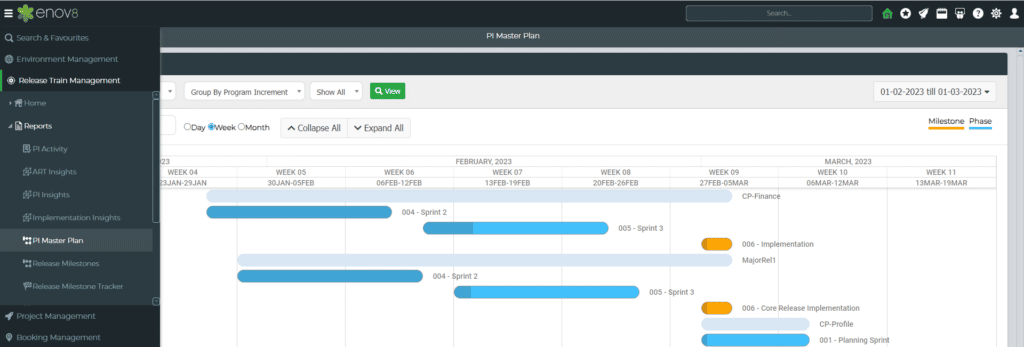
Release entry and exit criteria are important components of software development projects that help ensure successful releases. To release a new software version, it is crucial to have clear criteria for when you initiate a release (entry criteria).
Additionally, you need to know what you need to achieve before considering the release complete (exit criteria).
Without well-defined criteria, ensuring you test the software thoroughly is difficult. It’s also difficult to know if the software meets stakeholder expectations. And when is the software ready for deployment?
Through mature release planning and defining release entry and exit criteria, software development teams can reduce risk. This improves communication and collaboration among stakeholders. In addition, it ensures that the release is successful.
In this post, we will explore the importance of defining release entry and exit criteria and provide examples of each. We will also discuss the benefits of having a criterion that is well defined. Finally, we will provide best practices for defining and implementing them.
Release Entry Criteria
Release entry criteria are the conditions that the software meets before you initiate a release. They serve as a checklist of requirements that the software must meet before it is ready for release. Defining these criteria helps ensure that the software is adequately tested. It should also meet stakeholder expectations and be ready for deployment.
Some examples of release entry criteria include:
- All tests are complete and pass the criteria
- The software meets all functional and non-functional requirements
- Obtaining approval from all relevant stakeholders
- Resolving all defects and issues identified during testing
- Documentation is complete and up-to-date
It is important to involve all stakeholders in defining release entry criteria. Including product lifecycle owners, developers, testers, project managers, and business analysts. This ensures you consider all aspects of the software development process. It also ensures everyone aligns with the requirements for initiating a release.
Regularly reviewing and updating release entry criteria throughout the development process is also important. Altogether, it ensures that the criteria remain relevant and achievable. When teams set clear and well-defined entry criteria, they can reduce the risk of releasing software that is not ready.
Eventually, it can lead to delays, increased costs, and decreased stakeholder satisfaction.

Entry and Exit Criteria Explained in Testing Phases
In software testing, entry and exit criteria ensure that each testing phase progresses effectively and efficiently. Let’s cover how to apply entry and exit criteria in each phase of the testing process:
1. Entry and Exit Criteria in Test Planning
- Entry Criteria: Test planning begins when you finalize the software requirements and develop the test strategy and test plan.
- Exit Criteria: Test planning concludes when you review and approve the test plan. The testing team is now ready to proceed with test design and execution.
2. Entry and Exit Criteria in Test Design
- Entry Criteria: Test design commences when you finalize the test plan and prepare test cases based on the specified requirements and test objectives.
- Exit Criteria: Test design concludes when you review and review all test cases. It ensures comprehensive coverage of the test scope.
3. Entry and Exit Criteria in Test Execution
- Entry Criteria: Test execution begins when the test environment is set up, and you prepare the test data. You then execute the test cases and test scripts as per the test plan.
- Exit Criteria: Test execution concludes when you execute all test cases and then log and track defects. You analyze test results to determine if the exit criteria defined in the test plan are met.
4. Entry and Exit Criteria in Test Closure
- Entry Criteria: Test closure begins when you complete the test execution. You can also resolve or defer defects. Test closure activities, such as test summary report preparation, commence.
- Exit Criteria: Test closure concludes when the relevant stakeholders review and approve the test summary. The testing team obtains sign-off for closing the testing phase.

Entry and Exit Criteria Explained for Different Types of Testing
Additionally, you can also apply entry and exit criteria in the following main phases of software testing.
1. Unit Testing
- Entry Criteria: The code should be ready for testing, and you should prepare unit test cases.
- Exit Criteria: All unit tests should pass, and the code coverage should meet the predefined threshold.
2. Integration Testing
- Entry Criteria: Unit-tested modules should be available. The team should also design integration test cases.
- Exit Criteria: Integration tests should pass. The team should also resolve or log integration defects for further investigation.
3. System Testing
- Entry Criteria: Integrated system components should be ready, and you should define system test cases.
- Exit Criteria: System tests should pass, and you should fix or defer all high-priority defects.
4. Acceptance Testing
- Entry Criteria: The system should be stable, and you should finalize all acceptance test cases.
- Exit Criteria: Acceptance criteria should be met, and stakeholders should approve the system for release.
5. Regression Testing
- Entry Criteria: After each change or enhancement to the system.
- Exit Criteria: All regression test cases should pass, ensuring that the changes do not introduce new defects.
6. Performance Testing
- Entry Criteria: The test environment should be set up, and the team should define performance test scenarios.
- Exit Criteria: Performance benchmarks should be met, and the team should resolve or mitigate performance-related defects.
7. Security Testing
- Entry Criteria: The security test environment should be ready, and the team should prepare security test cases.
- Exit Criteria: The team should identify security vulnerabilities and address them, ensuring the system’s resilience against potential threats.

Common Reasons Why Release Gates Are Often Bypassed
Despite the importance of release gates in ensuring the quality and stability of software releases, they are sometimes bypassed due to various reasons:
- Time Pressure: Tight project deadlines may compel teams to bypass release gates to expedite the release process, risking the introduction of untested or unstable features.
- Lack of Resources: Insufficient resources, such as limited testing environments or personnel, may lead to the bypassing of release gates to avoid delays in the release schedule.
- Miscommunication: Poor communication between development, testing, and operations teams may result in misunderstandings regarding release criteria, leading to the inadvertent bypassing of release gates.
- Urgent Fixes: Critical production issues or customer-reported bugs may prompt teams to bypass release gates to deploy emergency fixes, prioritizing immediate resolution over adherence to release processes.
- Pressure to Deliver Features: Business demands for rapid feature delivery may override the need for thorough testing, incentivizing teams to bypass release gates to meet stakeholder expectations.

Release Exit Criteria
Release exit criteria are the conditions that must be met before considering a release complete. They serve as a checklist of requirements that the software must meet before you can deploy and release it to end-users.
Some examples of release exit criteria include:
- The software has been successfully deployed to the production environment
- Completion and sign-off of user acceptance testing.
- Resolving all defects and issues identified during testing.
- Documentation is complete and up-to-date
- Support and maintenance processes are in place and documented
Meeting all release exit criteria is crucial to ensure the release succeeds and meets stakeholder expectations. It is important to involve all relevant stakeholders in defining and agreeing on the exit criteria. Altogether, it ensures that everyone aligns with what the company needs to achieve before considering the release complete.
Regularly reviewing and updating release exit criteria throughout the development process is also important. It ensures that the criteria remain relevant and achievable.
When software development teams set clear and well-defined exit criteria, they can ensure that the software is ready for deployment. In summary, it can reduce the risk of issues arising after the company deploys the release to end-users.

Benefits of Defined Criteria
Having well-defined release entry and exit criteria can provide numerous benefits to software development projects, including:
- Reducing risk: It helps software development teams reduce the risk of releasing software that is not ready or that contains critical defects.
- Ensuring stakeholder expectations are met: Defined criteria ensure that everyone aligns with what the company needs to achieve before initiating and completing the release. Additionally, it can help ensure that the release meets stakeholder expectations.
- Improving collaboration and communication: Collaboration and communication help improve teamwork. Furthermore, it will ensure that everyone is working towards the same goals.
- Streamlining the release process: Software development teams can streamline the release process. Eventually, it ensures the completion of all necessary steps before the company deploys the release to end users.
- Increasing efficiency and productivity: Having well-defined release entry and exit criteria can help software development teams work more efficiently and productively. With clear requirements and goals, teams can focus their efforts on what is necessary to complete the release. Eventually, they avoid wasting time on unnecessary tasks.
Best Practices for Defining Entry & Exit Criteria
Defining release entry and exit criteria is an important aspect of software development projects, and there are several best practices that teams can follow to ensure that the criteria are effective and relevant:
- Involve all stakeholders: It is important to involve all relevant stakeholders in defining and agreeing on release entry and exit criteria. This ensures that the team considers all aspects of the software development process. It ensures everyone aligns with the requirements for initiating and completing a release.
- Regularly review and update criteria: Release entry and exit criteria should be regularly reviewed and updated throughout the development process. This ensures that the criteria remain relevant and achievable as the software evolves.
- Be specific and measurable: Release entry and exit criteria should be specific and measurable. It makes it clear what the team needs to achieve and when to achieve it. Therefore, reducing ambiguity and increasing clarity.
- Document criteria: It is important to document release entry and exit criteria. It ensures that everyone is aware of the requirements and goals. Additionally, it can help track progress and ensure completion of all necessary steps.
- Test criteria: The team should test the release entry and exit criteria to ensure they are effective and achievable. Altogether, it can help identify any gaps or issues in the criteria.

Are Entry & Exit Criteria the Same as Milestones?
Entry and exit criteria are not the same as milestones in release planning. Milestones are specific points in time or events that mark progress towards a larger goal, while entry and exit criteria are the conditions that must be met to move from one stage of the development process to the next.
Entry and exit criteria support milestones by providing a framework for achieving each milestone.
Conclusion
In conclusion, defining release entry and exit criteria is a crucial aspect of software development projects. It ensures successful releases. Involving all stakeholders is crucial.
Additionally, regularly reviewing and updating criteria is important. With these criteria, software development teams can improve collaboration, reduce risk, and increase the chances of a successful release.
However, defining and managing release entry and exit criteria can be a challenging task. Particularly, for large or complex software development projects. To help with this challenge, use Enov8 Release Manager. It provides a centralized platform for managing release entry and exit criteria. As well as other aspects of the release management process.
With Enov8 Release Manager, teams can streamline their release process, reduce the risk of defects, and ensure that releases meet stakeholder expectations.
In summary, defining and managing release entry and exit criteria is an important part of software development projects. Following best practices and using tools like Enov8 Release Manager can help teams achieve success.

Post Author
Andrew Walker is a software architect with 10+ years of experience. Andrew is passionate about his craft, and he loves using his skills to design enterprise solutions for Enov8, in the areas of IT Environments, Release & Data Management.
